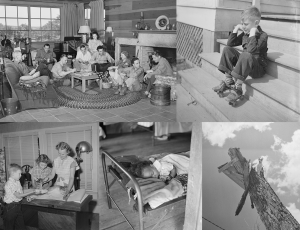
Top row: SMDR_1950s-SF-11_May 16 2017_13-38-29, SMDR_1930s-56_027 Bottom row: SMDR_1940s50s-88_001, SMDR_1930s-58_004, SMDR_1930s-26_016
In January of 2016 University Archives received an estimated 800,000 photo negatives, transparent strips of film that depict an image with the colors inverted, from the San Marcos Daily Record. This collection contains images spanning from the 1930s to the 2000s. The negatives consist of a mixture of nitrate and safety film. Nitrate film, a flexible, plastic film base, was created in the late 1800s as a replacement to glass plates and safety film was created as a substitute for nitrate. Nitrate film is the same film used in motion pictures which caused many devastating fires during film screenings in the early 1900s. This film becomes less stable and more likely to auto-ignite as it deteriorates. Safety film, as the name suggests, is much safer to use and store, however, the film still degrades over time.
Both the flammability and the dilapidated state of the oldest negatives forced us to move quickly with plans to digitize the entire collection. Upon receiving a Texas State Library and Archives TexTreasures Grant, funded by IMLS, we started looking for the right equipment with the hopes of creating a new system of digitization. Our previous digitization process involved flatbed scanners with which the scanning process alone can take five minutes per image.
We forged this new process with the goal that this system would digitize the negatives more quickly and produce higher quality images than the scanners we had been using. While there have been a few hiccups the project as a whole has been a success. We began digitizing in April of 2017 and as of now, we have over 6,000 images. Regarding the quality of our images, it can feel a bit like overkill as our process captures more information than exists in the earliest negatives. However, this process allows us to preserve as much of the detail in the negative as possible. These silhouette images, for instance, likely appeared to be more contrasted like a typical silhouette due to the printing process in the 1930s but with our system, we can see much more detail than just their silhouettes.
Through research of the San Marcos Daily Record’s microfilm, we’ve discovered many engaging stories from the negatives. Just a brief flip through some of the old newspapers added quite a bit to our understanding of the collection. While we did find articles that recounted events seen in the negatives very few of the earliest images we have were included in the paper. This is likely a result of the image printing process being too slow to include the photos in the paper.
At the start of this collection, we can see the photographers are not only documenting big events but they are capturing the realities of living in Central Texas which resulted in some interesting photos.
The fact that their pictures were not included in the newspaper also meant many of the earliest images were more of a family photo album than a periodical. This “photo album” is where we get the stories like that of Tommy and his many adventures.
This project is invaluable in terms of the research material that will be provided and the chance to connect with people of San Marcos while recreating the local history. Our goal is to make these images accessible not only to researchers but to the San Marcos community. We hope to tell the story of San Marcos with the help of those that know it best.
Check here for more updates and stories related to this project.
The provided images are a preview of work by the Digital & Web Services Department in conjunction with the University Archives.










